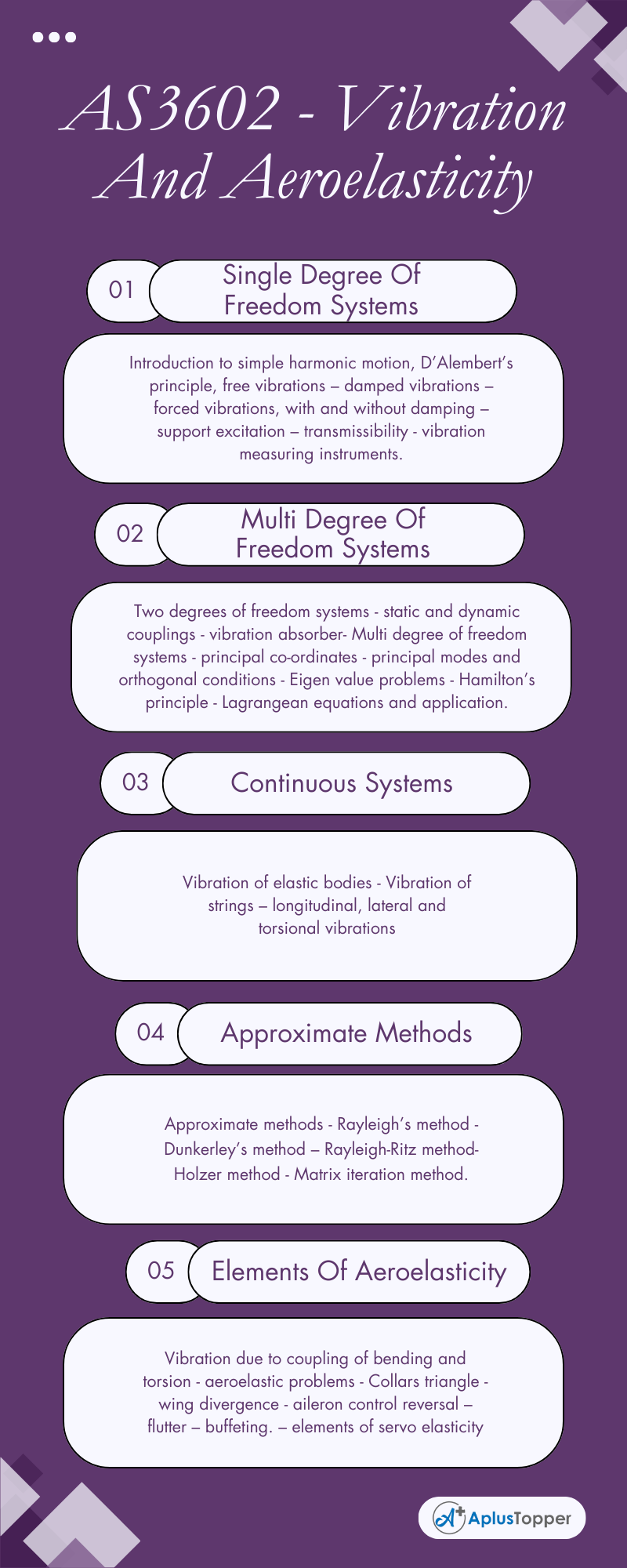In this article, we are glad to provide the syllabus of the code AS3602 of Anna University awarding the B.E Aerospace Engineering Syllabus based on regulation 2021. Let’s what we have here.
We tried our best to provide the detailed syllabus unit-wise for the subject code AS3602 – Vibration And Aeroelasticity Semester VI. We also include the required textbooks and references from the expert faculty regarding the syllabus. Along with it assists the students to become more aware of the topics. And can easily make preparation strategies as per the syllabus to make your move for examinations. Hope this information is useful. Comment below if you need anything relevant to the syllabus. We’ll try to answer your questions. Don’t forget to share with your classmates.
If you want to know more about the B.E Aerospace Engineering Syllabus connected to an affiliated institution’s four-year undergraduate degree program. We provide you with a detailed Year-wise, semester-wise, and Subject-wise syllabus in the following link B.E Aerospace Engineering Syllabus Regulation 2021 Anna University.
Aim Of Concept:
- To study the effect of time dependent forces on mechanical systems and to get the natural characteristics of system of single degree of freedom system
- To study the solving methods of multi degree of freedom systems.
- To introduce the approximates method to solve vibration problems.
- To make the student to understand the solving techniques of vibration of continuous system
- To study the aeroelastic effects of aircraft wings.
AS3602 – Vibration And Aeroelasticity Syllabus
Unit I: Single Degree Of Freedom Systems
Introduction to simple harmonic motion, D’Alembert’s principle, free vibrations – damped vibrations – forced vibrations, with and without damping – support excitation – transmissibility – vibration measuring instruments.
Unit II: Multi Degree Of Freedom Systems
Two degrees of freedom systems – static and dynamic couplings – vibration absorber- Multi degree of freedom systems – principal co-ordinates – principal modes and orthogonal conditions – Eigen value problems – Hamilton’s principle – Lagrangean equations and application.
Unit III: Continuous Systems
Vibration of elastic bodies – Vibration of strings – longitudinal, lateral and torsional vibrations
Unit IV: Approximate Methods
Approximate methods – Rayleigh’s method – Dunkerley’s method – Rayleigh-Ritz method- Holzer method – Matrix iteration method.

Unit V: Elements Of Aeroelasticity
Vibration due to coupling of bending and torsion – aeroelastic problems – Collars triangle – wing divergence – aileron control reversal – flutter – buffeting. – elements of servo elasticity
Text Books:
- Grover. G.K., “Mechanical Vibrations”, 7th Edition, Nem Chand Brothers, Roorkee, India, 2003
- Leonard Meirovitch, “Elements of Vibration Analysis”. McGraw Hill International Edition,2007
- Thomson W T, ‘Theory of Vibration with Application’ – CBS Publishers, 1990.
References:
- Bisplinghoff R.L., Ashely H and Hogman R.L., “Aeroelasticity”, Addision Wesley Publication, New Tork, 1983.
- Den Hartog, “Mechanical Vibrations” Crastre Press, 2008.
- TSE. F.S., Morse, I.F., Hinkle, R.T., “Mechanical Vibrations” – Prentice Hall, New York, 1984.
- William W Seto, “Mechanical Vibrations” – McGraw Hill, Schaum Series.
- William Weaver, Stephen P. Timoshenko, Donovan H. Yound, Donovan H. Young. ‘Vibration Problems in Engineering’ – John Wiley and Sons, New York, 2001
Related Posts On Semester – VI:
- AS3601 – Aerospace Control Engineering
- AE3581 – CAD Laboratory
- AS3611 – Space Launch Vehicle Design Project
Must Read For More:
